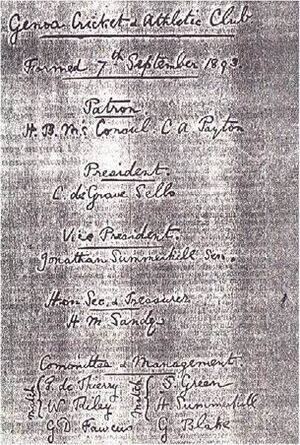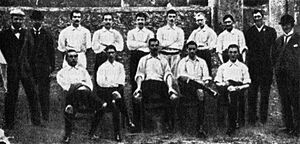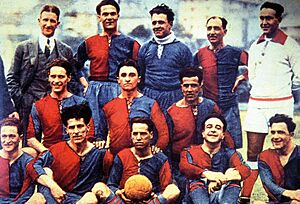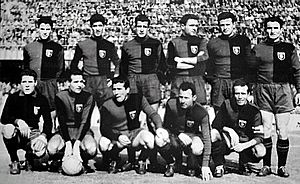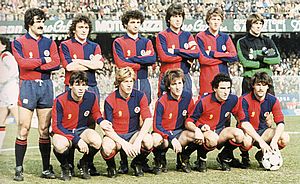History of Genoa CFC facts for kids
The club was started on September 7, 1893, and was first called Genoa Cricket & Athletic Club. In its early days, people mostly played athletics and cricket. Football was also played, but it wasn't the main focus.
The club was created to represent England in other countries, so the first uniforms were white, just like the England national team. At first, only English people could join because it was a private club. Genoa's activities took place in the Campasso area of the city. Some of the first people who managed the club were:
|
|
valign="top"
|
On April 10, 1897, the football part of the club became the most important, thanks to James Richardson Spensley. It was one of the oldest football clubs in Italy. At that time, only four other clubs had been started in Turin. Italians were then allowed to join, and the club found a new home ground called Ponte Carrega.
Genoa played its first friendly match at home against a mixed team from Internazionale Torino and FBC Torinese, losing 1–0. Soon after, Genoa won its first away game against UPS Alessandria with a score of 2–0. They also played friendly games against British sailors, like those from HMS Revenge.
Contents
The Early Days of Football Success
Winning the First Championships
Football in Italy grew bigger when the Italian Football Federation and the Italian Football Championship were created. Genoa played in the very first Italian Championship in 1898 in Turin. They won their first official game on May 8, beating Ginnastica Torino 2–1. Later that same day, they won the first championship by defeating Internazionale Torino 3–1 after extra time.
Genoa came back for the next season with some changes. The club's name became Genoa Cricket & Football Club, removing "Athletic." They also changed their uniform colors to white and blue vertical stripes, known as biancoblu in Italy. Genoa won its second title on April 16, 1899, by beating Internazionale Torino 3–1 again.
On their way to winning their third championship in a row in 1900, Genoa showed how strong they were. They beat local rivals Sampierdarenese 7–0. This huge win wasn't beaten by any other team in the league until 1910. They won the final with a 3–1 victory over FBC Torinese.
The club's uniform changed again in 1901. Genoa started wearing its famous red and navy halves, which is why they are known as the rossoblu today. After finishing second to Milan Cricket and Football Club one season, Genoa got back on track in 1902 and won their fourth title. Juventus became a strong competitor from 1903 onwards. For two seasons in a row, Genoa beat Juventus in the national final.
Genoa became the first Italian football team to play an international match. They visited France on April 27, 1903, to play FVC Nice and won 3–0. Besides winning the Italian championship in 1904, that year was also special because Genoa's reserve team won the first ever II Categoria league season. This was like an early version of Serie B, the second level of Italian football. From 1905 onwards, Genoa lost its strong hold on the Italian championship. Other clubs like Juventus, Milan, and Pro Vercelli started to win.
Part of the reason for this change was in 1908. The FIGC (Italian Football Federation) decided to ban foreign players. Since Genoa had always had many English players, they disagreed. Several other big clubs like Milan and Torino also disagreed, so they left the official FIGC competitions that year. The next season, the federation changed its mind, and Genoa rebuilt its team with players like Luigi Ferraris and some from Switzerland. The team also got a new home ground in the Marassi area of Genoa. When it was built, it could hold 25,000 people, similar to British stadiums at the time. It opened on January 22, 1911.
The Garbutt Era and More Wins
When the Italy national football team was formed, Genoa played an important part. Players like Renzo De Vecchi, who was the captain for a while, Edoardo Mariani, and Enrico Sardi were called up to play for Italy.
An Englishman named William Garbutt became the head coach to help the club get back to its winning ways. Garbutt was the first professional manager in Italy. He was known for his strong personality and always smoking his tobacco pipe. The players called him "Mister," and since then, Italians have used this term for coaches in general.
By 1914–15, Genoa was again the top club in Northern Italy, winning their section. However, a national final wasn't played because World War I started. Genoa was awarded the title in 1919 after the war ended. It was their first championship in eleven seasons. The war was very hard on Genoa. Players Luigi Ferraris, Adolfo Gnecco, Carlo Marassi, Alberto Sussone, and Claudio Casanova all died while serving in the military in Italy. The club's founder, James Richardson Spensley, was killed in Germany.
Right after the war, Genoa remained a strong team in the North. Garbutt led Genoa to win the championship in 1922–23. They beat Lazio 6–1 in the final over two games. The next season, Genoa got past Bologna in the Northern finals. There was some trouble in the second game in Bologna due to crowd issues, and the game was stopped. The FIGC then gave Genoa a 2–0 victory. In the national final that season, Genoa beat Savoia 4-1 over two games. This was their ninth, and so far, last Italian championship.
The team during these two championship wins included Giovanni De Prà, Ottavio Barbieri, Luigi Burlando, and Renzo De Vecchi. After Genoa's championship win in 1923–24, the scudetto patch was introduced. This means that after a club wins an Italian league championship, they get to wear a shield-shaped patch on their uniform with the colors of the Italian flag. For the rest of the 1920s, the club didn't win the championship. The highest they finished was second place, like in the 1927–28 season, when they were runners-up to Torino. Striker Felice Levratto scored 20 goals in 27 games that season.
The Genova 1893 Years
Because of its English name, Genoa was forced to change it by the fascist government in 1928. The new name was Genova 1893 Circolo del Calcio. The club played in an early European competition called the Mitropa Cup. They were knocked out in the quarter-finals after losing to Rapid Vienna. They then finished second in their home league in the 1929–30 season, behind Ambrosiana. This was their last time finishing second in the top league.
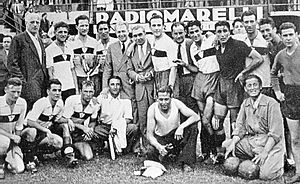
The club's league performance was very up and down in the early 1930s. In the 1933–34 season, Genova was relegated for the first time to Serie B, the second level of Italian football. Luckily, the club was able to return quickly under manager Vittorio Faroppa, winning promotion by finishing first in their group ahead of Novara. In 1936, Juan Culiolo became the ambitious new president of the club. In 1936–37, they finished 6th and also won the Coppa Italia (Italian Cup) by beating AS Roma 1–0 with a goal from Mario Torti.
The next season, Genova finished in third place. It was a very close season, with winners Ambrosiana-Inter finishing only three points ahead of the club. That summer, Italy won the 1938 FIFA World Cup. Three Genova players, Sergio Bertoni, Mario Genta, and Mario Perazzolo, were part of that winning team. The club ended the decade strongly, staying in the top five of the Italian league.
World War II greatly affected Italian football. In 1945, the club decided to change its name back to Genoa Cricket and Football Club, the name they used in the very early days. After the war, the club was still popular with fans. People who had been with the club before, like Ottavio Barbieri and William Garbutt, returned as managers. Genoa also got a new rival, Sampdoria, which was formed by two other clubs merging in 1946. Both teams would share the Stadio Luigi Ferraris stadium.
After the War: Ups and Downs
After World War II, Genoa's ability to finish at the top of Serie A decreased. Through the rest of the 1940s, the club usually finished in the middle of the table. The 1948–49 season saw three very big wins: Genoa beat Inter 4–1, the famous Grande Torino team 3–0, and Padova 7–1.
The 1950s started poorly for the club. They bought Argentine player Mario Boyé from Boca Juniors, but he only stayed one season. The club was relegated after finishing last in the table. However, after two seasons, they returned to Serie A by winning Serie B, ahead of Legnano. Ragnar Nikolay Larsen was a notable player for the club during this time, and they managed to stay in the middle of the table for the rest of the decade.
Even though they were relegated in 1959–60 and then promoted back to Serie A in 1961–62, Genoa had some good cup success in the first half of the 1960s. The club won the Coppa delle Alpi in 1962. It was the first time this competition was played between club teams instead of national teams. The final was played at home, and Genoa beat French club Grenoble Foot 38 1–0 with a goal from Nizza. Genoa won the same competition again two years later. The final was held in Switzerland, where Genoa defeated Catania 2–0, with both goals from Giampaolo Piaceri, to win the trophy.
However, the celebrations didn't last long. The year after their last cup success, they were relegated to Serie B again. This time, their stay in the second division of the Italian football system was much longer than before. The club was not stable and changed managers every season. Genoa even experienced its first relegation to Serie C in 1970. Financially, the club faced difficulties and had several changes in ownership.
A Time of Mixed Results
Throughout the 1970s, Genoa often moved up and down between divisions. Under manager Arturo Silvestri, the club returned to Serie A for the 1973–74 season, but they were relegated right back down. For the return of Il Grifone (The Griffin, Genoa's nickname) to Serie A a couple of seasons later, the team included players like Roberto Rosato, Bruno Conti, and a young Roberto Pruzzo. This time, they stayed in the top division for two seasons before being relegated in 1977–78. This relegation was especially tough because the team above them, Fiorentina, survived only by a single goal difference. The two teams had played each other on the last day of the season, ending in a 0–0 draw.
The relegation was bad for the club in several ways. They lost some of their best players who could have helped them return quickly. For example, Roberto Pruzzo moved to AS Roma, where he became very successful. After a couple of seasons finishing in the middle of Serie B, Genoa earned promotion during the 1980–81 season under manager Luigi Simoni. The club finished second, behind only AC Milan, who had been relegated the previous season due to a betting scandal.
With Simoni still as manager, Genoa managed to stay in Serie A for their return season. They finished just one point ahead of the relegated AC Milan. It was a dramatic last day of the season. Genoa was losing 2–1 to SSC Napoli with five minutes left, until Mario Faccenda scored a goal in the 85th minute. This goal secured the point Genoa needed, starting a friendship between the fans of the two clubs.
A couple of seasons later, in 1983–84, Genoa wasn't as lucky. Even though they beat champions Juventus on the final day of the season, the club was relegated. They finished the season with the same number of points as Lazio, who survived. This was because Lazio had better results in their matches against Genoa.
Playing in Europe
A businessman from Calabria named Aldo Spinelli bought the club in 1985. Even without Simoni as manager, Genoa was finishing in the top half of Serie B. After a dip in form in 1987–88, Genoa refocused and achieved promotion back into Serie A the next season, finishing as champions ahead of Bari.
Genoa reached a high point during the 1990–91 season, finishing fourth. They were undefeated at home for the entire season, winning games against all the big teams like Juventus, Inter, AC Milan, Roma, Lazio, Fiorentina, SSC Napoli, and their rivals Sampdoria, who won the title that season.
Because of their high finish, the club entered the UEFA Cup in the 1991–92 season. Genoa had a great run, reaching the semi-finals before being knocked out by Ajax. Notably, Genoa beat Liverpool twice in the quarter-finals, becoming the first Italian team to beat Liverpool at their home stadium, Anfield.
However, back in Serie A, the team struggled because they had a small squad of main players. The success in the UEFA Cup meant more matches and tiring trips, which affected their league performance. Genoa finished just one place above the relegation zone. In the seasons that followed, Genoa remained in the lower half of the table.
During the 1994–95 season, Genoa was narrowly relegated. They finished with the same points as Padova after the regular season. This meant they had to play a special relegation match in Florence. The game was tied 1–1 at full-time and went to a penalty shootout. Genoa eventually lost the shootout 5–4.
While back in Serie B, the club had another taste of international cup success. They became the final winners of the Anglo-Italian Cup by beating Port Vale 5–2, with Gennaro Ruotolo scoring three goals. Chairman Spinelli sold Genoa in 1997 and moved to Livorno. The late 1990s and early 2000s were very difficult for the club, with many changes in managers, financial problems, and little hope of promotion, except for a decent 6th-place finish in 1999–00. From 1997 to 2003, Genoa had three different chairmen before Enrico Preziosi took over.
Recent Times: Back to Serie A
After the new owner took over in 2003, things started to improve for Genoa. They won Serie B in 2004–05. However, there were claims that the club had fixed a match on the last day of the season against Venezia. The 3–2 victory in that match saw Genoa win the league. If they had lost, they would have finished behind three other teams. The Disciplinary Committee of FIGC decided to place Genoa at the bottom of the league and relegate them to Serie C1 on July 27, 2005.
For their season in Serie C1 in 2005–06, Genoa started with a six-point penalty from the previous season. After leading for much of the season, they eventually finished second. They entered the play-offs, beating Monza 3–0 over two games to get promoted back into Serie B.
During the summer break, Gian Piero Gasperini became the new manager. He helped the club get promoted during the 2006–07 season. This was confirmed on the last day of the season when they drew 0–0 with Napoli. Both teams, which had been "sleeping giants," were promoted back into Serie A.
In the 2008-2009 championship, Genoa started with a loss away to Catania. But then, Argentinian forward Diego Milito returned. He had played for Genoa in the second division and was sold after the team was relegated to the third division due to a past controversy. Milito was happy to come back to Genoa and play in Italy's Serie A. He greatly helped the team have a very successful season, finishing fifth and earning a spot in the UEFA Cup. They also won both derby matches against their rivals Sampdoria and managed to beat teams like Roma, Milan, and Juventus.
Genoa could have aimed even higher, but an unlucky series of losses to Lazio and Bologna, right after beating Juventus, ended their hopes for a Champions League spot. After selling both Milito and midfielder Thiago Motta to Inter, Genoa had 40 million euros to invest in new players to stay strong in the coming Serie A season and compete well in the UEFA Cup.


